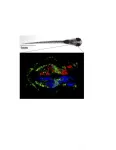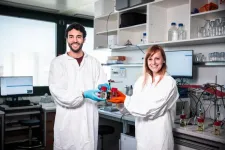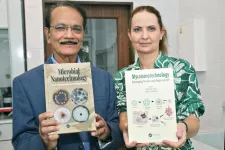(Press-News.org) BOSTON – Researchers who previously developed the first 3D human cell culture models of Alzheimer’s disease (AD) that displays two major hallmarks of the condition—the generation of amyloid beta deposits followed by tau tangles—have now used their model to investigate whether the exercise-induced muscle hormone irisin affects amyloid beta pathology.
As reported in the journal Neuron, the Massachusetts General Hospital (MGH)–led team has uncovered promising results suggesting that irisin-based therapies might help combat AD.
Physical exercise has been shown to reduce amyloid beta deposits in various mouse models of AD, but the mechanisms involved have remained a mystery.
Exercise increases circulating levels of the muscle-derived hormone irisin, which regulates glucose and lipid metabolism in fat tissue and increases energy expenditure by accelerating the browning of white fat tissue.
Studies have revealed that irisin is present in human and mouse brains and that its levels are reduced in patients with AD and in mouse models of the condition.
To test whether irisin plays a causal role in the link between exercise and reduced amyloid beta, Se Hoon Choi, PhD and Eun Hee Kim, PhD, of the Genetics and Aging Research Unit at MGH, along with additional research colleagues applied the hormone to their 3D cell culture model of AD.
“First, we found that irisin treatment led to a remarkable reduction of amyloid beta pathology,” says Choi. “Second, we showed this effect of irisin was attributable to increased neprilysin activity owing to increased levels of neprilysin secreted from cells in the brain called astrocytes.”
Neprilysin is an amyloid beta–degrading enzyme that has been found to be elevated in the brains of mice with AD that were exposed to exercise or other conditions leading to reduced amyloid beta.
The researchers uncovered even more details about the mechanisms behind irisin’s link to reduced amyloid beta levels. For example, they identified integrin αV/β5 as the receptor that irisin binds to on astrocytes to trigger the cells to increase neprilysin levels.
Furthermore, they discovered that irisin’s binding to this receptor causes reduced signaling of pathways involving two key proteins: extracellular signal-regulated kinase (ERK) and signal activator of transcription 3 (STAT3). Reduced ERK-STAT3 signaling was critical for irisin-induced enhancement of neprilysin.
Previous studies have shown that in mice, irisin injected into the blood stream can make its way into the brain, making it potentially useful as a therapeutic.
“Our findings indicate that irisin is a major mediator of exercise-induced increases in neprilysin levels leading to reduced amyloid beta burden, suggesting a new target pathway for therapies aimed at the prevention and treatment of Alzheimer’s disease,” says Rudolph Tanzi, PhD, a senior author of the study and director of the Genetics and Aging Research Unit.
Additional co-authors include Hyeonwoo Kim, Mark P. Jedrychowski, Grisilda Bakiasi, Joseph Park, Jane Kruskop, Younjung Choi, Sang Su Kwak, Luisa Quinti, Doo Yeon Kim, Christiane D. Wrann, and Bruce M. Spiegelman.
This research was supported by Cure Alzheimer’s Fund (R.E.T., S.H.C., and C.D.W.); JPB Foundation (R.E.T. and B.M.S.); NIH R56AG072054 and 1R21AG062904 (S.H.C. and C.D.W.); Coins for Alzheimer’s Research Trust (S.H.C.), and BrightFocus Foundation Fellowship A2020870F (E.K.).
About the Massachusetts General Hospital
Massachusetts General Hospital, founded in 1811, is the original and largest teaching hospital of Harvard Medical School. The Mass General Research Institute conducts the largest hospital-based research program in the nation, with annual research operations of more than $1 billion and comprises more than 9,500 researchers working across more than 30 institutes, centers and departments. In July 2022, Mass General was named #8 in the U.S. News & World Report list of "America’s Best Hospitals." MGH is a founding member of the Mass General Brigham healthcare system.
END
Exercise-induced hormone irisin may reduce Alzheimer’s disease plaque and tangle pathology in the brain
New findings offer strong support for developing irisin as a therapeutic target for Alzheimer’s disease treatment and prevention.
2023-09-08
ELSE PRESS RELEASES FROM THIS DATE:
Immunogenicity and reactogenicity of co-administration of COVID-19 and influenza vaccines
2023-09-08
About The Study: In this study of health care workers who received a COVID-19 vaccine, an influenza vaccine, or both, co-administration was not associated with substantially inferior immune response or to more frequent adverse events compared with COVID-19 vaccine administration alone, supporting the co-administration of these vaccines.
Authors: Gili Regev-Yochay, M.D., of the Sheba Medical Center in Ramat Gan, Israel, is the corresponding author.
To access the embargoed study: Visit our For The Media website at this link https://media.jamanetwork.com/
(doi:10.1001/jamanetworkopen.2023.32813)
Editor’s ...
Readmission rates after acute respiratory distress syndrome in children
2023-09-08
About The Study: The findings of this study suggest that childhood survivors of acute respiratory distress syndrome (ARDS) are at high risk of readmission in the first two months after discharge. Future studies should evaluate whether post-discharge interventions (e.g., telephonic contact, follow-up clinics, and home health care) may help reduce the readmission burden.
Authors: Garrett Keim, M.D., of Children’s Hospital of Philadelphia, is the corresponding author.
To access the embargoed study: Visit our For The Media website at this link https://media.jamanetwork.com/
(doi:10.1001/jamanetworkopen.2023.30774)
Editor’s ...
Ballet of the brain: Unlocking the choreography of movement
2023-09-08
The zebrafish brain, though simpler than its human counterpart, is a complex network of neurons that engage in a ceaseless dance of electrical activity. What if this neural ballet could reveal the secrets of how brains, including our own, control movement? A zebrafish study led by researchers at the Champalimaud Foundation offers a new lens through which to view the activity of neural populations, and to understand how the brain orchestrates motion.
Why we have a brain
“The brain’s primary function is movement”, explains Claudia Feierstein, lead author of the study ...
Bacteria generate electricity from wastewater
2023-09-08
“We engineered E. coli bacteria, the most widely studied microbe, to generate electricity,” says Professor Ardemis Boghossian at EPFL. “Though there are exotic microbes that naturally produce electricity, they can only do so in the presence of specific chemicals. E. coli can grow on a wide range of sources, which allowed us to produce electricity in a wide range of environments, including from waste water.”
In a paper published in the journal Joule, Boghossian’s team report a groundbreaking achievement in bioelectronics, advancing the capabilities of common E. coli bacteria to generate ...
Probing the unimaginable: New data help to understand the nature of aphantasia
2023-09-08
The ability to visualize faces, objects, landscapes, or even scenes from the past exists on a spectrum. While some can picture the layout of a city in minute detail and mentally walk through it, street by street, others have a perfectly blank internal cinema. In this case, we speak of aphantasia—the inability to voluntarily produce the visual mental image corresponding to an idea.
People whose aphantasia is congenital—i.e., not due to a stroke, brain injury, or psychiatric illness—become aware of their peculiarity reasonably ...
Artificial Intelligence: a step change in climate modelling predictions for climate adaptation
2023-09-08
As of today, climate models face the challenge of providing the high-resolution predictions - with quantified uncertainties - needed by a growing number of adaptation planners, from local decision-makers to the private sector, who require detailed assessments of the climate risks they may face locally.
This calls for a step change in the accuracy and usability of climate predictions that, according to the authors of the paper “Harnessing AI and computing to advance climate modelling and prediction”, can ...
Study hints at the existence of the closest black holes to Earth in the Hyades star cluster
2023-09-08
A paper published in the journal Monthly Notices of the Royal Astronomical Society hints at the existence of several black holes in the Hyades cluster — the closest open cluster to our solar system — which would make them the closest black holes to Earth ever detected. The study results from a collaboration between a group of scientists led by Stefano Torniamenti, from the University of Padua (Italy), with the significant participation of with Mark Gieles, ICREA professor at the Faculty of Physics, the ...
The 10th Heidelberg Laureate Forum is just around the corner!
2023-09-08
This September 24–29, at the 10th Heidelberg Laureate Forum (HLF), 200 young researchers in mathematics and computer science will spend a week of scientific exchange with the recipients of the disciplines’ most prestigious prizes: the Abel Prize, ACM A.M. Turing Award, ACM Prize in Computing, Fields Medal, the Nevanlinna Prize as well as its continuation, the IMU Abacus Medal. Below are a few highlights of the upcoming program of the HLF as well as a breakdown of how to cover this unique event.
More ...
The green power of fungi
2023-09-08
Nanoparticles are tiny structures up to 100 nanometers in size. They are characterized by different physical and chemical properties and biological activity than their larger material counterparts. - When the starting material on a micro-scale with a specific surface area is broken down to nano size, i.e. into smaller particles, its surface area will increase many times. And it is the ratio of surface to volume that results in the unique properties of nanoparticles, explains Prof. Mahendra Rai from Sant Gadge Baba Amravati University in India.
Nanoparticles can be mainly ...
Liver cancer and severe liver disease more common if a close relative has fatty liver disease
2023-09-08
Close relatives of people with metabolic-associated fatty liver disease have a higher risk of developing liver cancer and dying from liver-related diseases, according to a national study from Karolinska Institutet in Sweden published in The Journal of Hepatology. This means that family members could also benefit from the lifestyle advice that is currently only given to patients, the researchers conclude.
People with metabolic-associated fatty liver disease (MASLD, formerly known as NAFLD – see fact box) have an elevated risk of developing and dying from liver cancer. MASLD is now the main reason why the number of people developing liver cancer ...
LAST 30 PRESS RELEASES:
Electrodes created using light
Second-hand gift-giving is a well-deliberated decision
How human interaction drove evolution to make bears less aggressive
National Poll: Few parents offer teens guidance on healthy eating during holiday season
Cannabis derivatives could provide new ovarian cancer treatments
Raising strong yeast as a petroleum substitute
Clues to the origin of hot Jupiters hidden in their orbits
Canada’s reduced pledge to Global Fund will impact domestic health
1 in 4 children with major traumatic injuries not cared for in pediatric trauma centres
Duke and Duke-NUS’ joint cross-population research to uncover "East-West" differences in disease and care
Scientists to ‘spy’ on cancer- immune cell interactions using quantum technology breakthrough
Tech savvy users have most digital concerns
Making lighter work of calculating fluid and heat flow
Normalizing blood sugar can halve heart attack risk
Lowering blood sugar cuts heart attack risk in people with prediabetes
Study links genetic variants to risk of blinding eye disease in premature infants
Non-opioid ‘pain sponge’ therapy halts cartilage degeneration and relieves chronic pain
AI can pick up cultural values by mimicking how kids learn
China’s ecological redlines offer fast track to 30 x 30 global conservation goal
Invisible indoor threats: emerging household contaminants and their growing risks to human health
Adding antibody treatment to chemo boosts outcomes for children with rare cancer
Germline pathogenic variants among women without a history of breast cancer
Tanning beds triple melanoma risk, potentially causing broad DNA damage
Unique bond identified as key to viral infection speed
Indoor tanning makes youthful skin much older on a genetic level
Mouse model sheds new light on the causes and potential solutions to human GI problems linked to muscular dystrophy
The Journal of Nuclear Medicine ahead-of-print tip sheet: December 12, 2025
Smarter tools for peering into the microscopic world
Applications open for funding to conduct research in the Kinsey Institute archives
Global measure underestimates the severity of food insecurity
[Press-News.org] Exercise-induced hormone irisin may reduce Alzheimer’s disease plaque and tangle pathology in the brainNew findings offer strong support for developing irisin as a therapeutic target for Alzheimer’s disease treatment and prevention.




